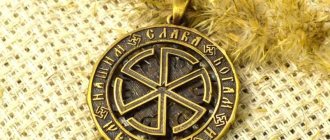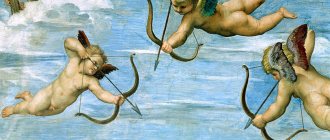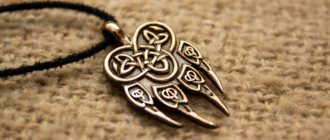The Slavs believed that Perun protected not only warriors, but also civilians. His ax was considered a sacred object, a symbol of victory over evil. Perun, the thunderer, son of Lada and Svarog, occupies an important place in the Slavic pantheon. All objects associated with him, according to legend, are endowed with magical powers.
ATTENTION! If a person wears an imperial amulet on himself, he will never be poor. His debts are closed and a streak of luck sets in, which brings him into a comfortable life. With an imperial amulet, money will come in abundance - there will be much more of it than you expect... Read more"
Legend of the origin of the symbol
The ax of Perun, like most other symbols, has a unique origin story. In fact, it can be called a legend, since information about the appearance of this sign is quite inaccurate and does not contain historical facts.
Legends say that Perun used a huge ax during the battle with Veles, who took the form of a Serpent. According to the legends, the reason for the battle was that the Serpent began to absorb sunlight. However, there are other versions. Some argued that the main reason was that Veles kidnapped Perun's beloved.
Perun managed to defeat the evil Serpent. After this battle, his ax gained enormous power. It became the main attribute of Perun, which many people later began to use as a talisman.
Unlike other amulets and amulets, the Ax of Perun has a rather attractive and at the same time unusual appearance.
Appearance
It is worth noting that the appearance of an ax as a weapon is often different. The fact is that it can have one or more sharp blades. The body amulet also has a different appearance. Perun is often depicted with both a one-sided and a double-sided axe.
It is no secret that this symbol is often used in the manufacture of body jewelry. The god of thunder and lightning is usually depicted only with a one-sided axe. This option is considered more beautiful and versatile.
However, in rare cases, there are still decorations that depict a double-sided axe.
The ax is often worn as a neck amulet
On Slavic amulets it is customary to depict axes with decorations. On their blade you can see quite original and unusual engravings.
For example, on amulets, Perun’s hammer is decorated with various signs of the Thunderer. Images that contain the following elements are also used as patterns:
- abstract figures with unusual ornaments;
- metal helmets, huge axes, wooden boats and other items that are somehow related to Vikings and Scandinavian themes;
- wild animals and livestock.
In rare cases, an ax amulet is additionally decorated with images of fish and snakes.
Despite the type of ax used, in jewelry and amulets the symbol of Perun’s Ax is always depicted as symmetrical. Another distinctive feature is the rather wide and thick blade, which is slightly rounded near the edges.
The presence of engravings is a distinctive feature of this symbol
The meaning of Perun's ax amulet
A strong amulet is closely related to the Fire element. The lightning itself fills Perun's ax with energy, so such a talisman protects it very powerfully, lightning fast and strong.
The ax is an integral part of Perun's appearance. She has a piece of divine energy in her. In addition, the ax is part of the fire or electric element. The amulet affects enemies directly, quickly and mercilessly.
Perun's weapon symbolizes victory in close combat. Since the amulet arose after a successful victory, the ax can be considered a versatile talisman, and not just a protective amulet.
Typically, such an ax has certain decorations that enhance its effect. Other sacred symbols are applied to it: a Kolovrat, a star or an image of a fern. The thunder symbol enhances the effect of the amulet many times over. It is permissible to use an ax with one blade, although the more ancient version of the amulet has two double-edged blades on a powerful handle.
Often on axes of later times you can find Slavic writing, where various mottos are indicated that raise morale. The ax is important for both fighters and ordinary people. With its help you can do a lot of good, not just win in battle.
Who should wear such a talisman and how?
Before putting on amulets with the Ax of Perun, you need to familiarize yourself with the features of wearing it.
The ax is a symbol of real warriors and that is why such amulets were originally intended specifically for them. They were charged with the warlike energy of Perun, which later helped them during battles.
Times are changing and today such amulets can be worn not only by warriors, but also by ordinary men.
However, not every guy can use it. This amulet should be used by men who want to change their character and harden it a little.
Therefore, most often the Ax of Perun is worn by insecure and weak people who want to radically change themselves and their lives. Of course, strong personalities can also use the symbol. However, they should not wear it for too long.
Such a talisman helps people not only decide on goals in life, but also achieve them in the future. However, for it to really help, you must try to carefully think through your goals and only after that start doing something.
Perun's ax is a universal amulet that is suitable for both men and women
It is worth noting that not only men, but also women can use such a symbol. His energy can transform any girl and make her a pretty strong warrior.
The symbol is also suitable for people whose profession involves making difficult decisions. In such cases, you need to wear the amulet while performing the most difficult tasks. This will help you gain strength and cope with any difficulties.
Some believe that such amulets can protect children and charge them with protective energy. However, in fact, such amulets are only suitable for adult men and women.
Children should not wear Perun's Axe, as they are still too small. They will not be able to cope with the powerful energy that comes from such an ax amulet.
What does Perun's Ax look like?
Perun's ax is usually decorated with various signs bearing the power of the Thunder God and the valiant Warrior God. With such an ax Perun fought against the ancient Serpent, who once plunged the whole World into darkness, and against all the enemies of his native land. The meaning of the ax for the Slavs is a badge of honor and a symbol with powerful protective powers. A wooden amulet was most often made from oak, but more often it was made from metals - iron, bronze, silver.
Image of the talisman ax of Perun
Perun's ax could sometimes be confused with Perun's Axe (Sokira). But these two symbols still have their differences. The first resembles a modern ax in outline, and the second has a wide blade, pointed in two directions. The shapes of ax blades can be different - with a pointed and curved end, a straight blade, the letter “G” or “L”, with notches, three-dimensional patterns, even runic inscriptions. The signs that are made on Perun's ax mean Perun's symbolism - lightning and multiple zigzags. There are decorations with symbols of Perun’s parents – the Star of Lada or the Square of Svarog.
The Ax of Perun is only one of the amulets with the power of Perun - the Thunderer. You can see other amulets on the page Symbol of the sign of God Perun: history, action, who is suitable.
How can you charge the talisman?
Having familiarized yourself with the purpose of the amulet with Perun’s hatchet, you need to figure out how it can be charged.
In the old days, people professionally engaged in crafts independently made such amulets and endowed them with quite strong energy. Nowadays, quite a few people can charge talismans on their own. Many people simply buy ready-made amulets from craftsmen. However, even they require activation and therefore, before using such a talisman, it will have to be charged.
A dense forest is an ideal place to activate the talisman
The most common method of activating a talisman is to charge it with elemental energy. In this way, you can not only fill the talisman with positive energy, but also cleanse it of all bad things.
The activation procedure must necessarily be carried out in nature. A dense forest is ideal for this. You need to find a small clearing without trees.
- To begin the ritual, the amulet must be placed on the ground and lightly sprinkled with soil.
- After a few hours, it needs to be rinsed in a spring or river water.
- Then you need to light a small fire and dry the talisman over it.
When rinsing, you should not put liquid into plastic bottles, as the water in them may lose all its beneficial properties.
Symbol in tattoo art
The symbol of the Ax of Perun is often used to create tattoos.
This symbol is used not only in the manufacture of amulets, but also in creating tattoos. The general meaning of this tattoo is the same as that of a talisman - protection, power and strength. In the old days, such tattoos were given to warriors to help them in battle. Now everyone can decorate their body with the Ax of Perun.
You can get a tattoo on any part of the body. The placement of the tattoo largely depends on its size. For example, if it is too big, then it is better to do it on the back. Smaller tattoos can be placed on the forearm, wrist or shoulders.
The ax of Perun is an ancient Slavic symbol that is often used in the making of amulets. People who are going to wear such a talisman should figure out in advance what the symbol of the ax is and what kind of people it is most suitable for.
Old Russian hatchet amulets
Bronze hatchet pendants are among the most expressive material monuments associated with ancient Russian paganism. These objects, more often than other amulets, are used to reconstruct the pre-Christian beliefs of the Eastern Slavs [1, p. 546; 2, p. 267; 3, p. 248]. They were examined in most detail in a special article by V.P. Darkevich, who collected data on a significant series of hatchet pendants and systematized this material [4, p. 91-102]. V. P. Darkevich’s conclusion that such pendants depicted the weapons of the Slavic thunder god Perun and were associated with his veneration has become firmly established in many general studies on ancient Russian culture. Over the three decades that have passed since the publication of V. P. Darkevich’s article, the collection of hatchet amulets has expanded significantly. New finds, many of which come from a dated cultural layer or from closed complexes, make it possible to significantly clarify the chronology and geography of the distribution of these objects. Methodological approaches to the study of archaeological materials related to the sphere of beliefs and cult are also changing. Therefore, today the question of the purpose of hatchet amulets and the religious beliefs associated with them is once again relevant, seemingly finally resolved 30 years ago.
Before moving on to a review and analysis of specific finds, it is advisable to formulate some general principles for the interpretation of archaeological materials related to the sphere of beliefs and cult. In modern studies, it is customary to consider these materials against a broad cultural and historical background, drawing on the widest possible range of analogies. The use of written sources, folklore texts and ethnographic materials to interpret archaeological finds has become the rule. In this way, the symbolism of amulets is revealed, the meaning of ornaments is restored, rituals are reconstructed, traces of which were recorded during the excavations. It is typical that similar techniques are used by both structuralists and researchers working within the framework of the traditional comparative historical method. This approach, on the one hand, allows one to achieve interesting results, but on the other hand, it opens up wide possibilities for subjective constructions - not all reconstructions based on a combination of heterogeneous and different materials turn out to be indisputable. The prospect of turning to written sources and ethnography to “decipher” archaeological materials often leads away from the analysis of the actual archaeological context of the finds. By “archaeological context” I mean the structure of the object itself (whether it is a separate object or an archaeological complex), the conditions of the find, its connection with other objects of the same monument, precise dating, a range of exact analogies, etc. When interpreting archaeological materials related to the sphere of cult, these operations, which provide the most accurate and reliable information about the object, must necessarily precede an analysis of the cultural and historical context. When considering hatchet amulets, I will follow this rule.
Rice. 1. Ax amulets of type I, 1 - Novgorod; 2, 15 - Nikolskoe III; 1, 4 – Sarkel; 5 – Bilyar; 6 – Perm province; 7, 11 – Prince Horus; 8 - ; 9 – Old Ryazan; 10 – Sins Brook; 12 – Suzdal; 13 – Annunciation; 14 – Vyzhumsky III burial ground; 16 – Settlement; 17 - Torgovitskoe; 18 – Tumie.
V.P. Darkevich took into account 25 bronze amulets-axes found both on the territory of Rus' and beyond [4, p. 92-93]. I have collected data on 62 miniature hatchets. Most of them belong to two standard types, identified by P. Paulsen and V.P. Darkevich, and only a few specimens have an individual - non-serial form.
The most numerous group consists of amulets imitating battle axes with a blade pulled down, a semicircular cutout at the base and an elongated carved butt - type IV, according to A. N. Kirpichnikov [5, p. Zb. 37, tab. XIII, 4-8, table. XXI, 1, 2, 8-12). There are 39 such pendants (Catalog, N, 1-36). Their length varies from 4 to 5.5 cm, blade width - from 2.8 to 4 cm. The similarity of amulets of this group with genuine battle axes was noted by a number of researchers: A. Nadolsky [6, p. 390], P. Paulsen [7, p. 195, 196], V.P. Darkevich [4, p. 92, 93]. Indeed, miniature hatchets reproduce not only the shape of type IV axes, but also many details: cape-shaped protrusions on the butt, two pairs of short cheeks, a through hole for attaching a sheath to the blade, and a spur on its inner side. On the neck of most specimens there are deep notches or small raised ridges, marking the transition from the blade to the butt. The ornamentation of amulets of this type is different. In 6 specimens, originating from the Kem necropolis, Novgorod, Sarkel, Staraya Russa and Bilyar, the lateral edges are bordered by a border of two (less often one) deep incised lines and small round depressions; along the edge of the blade, at some distance from it, there is a zigzag line with round depressions at the corners (Fig. 1, 1-5). Three hatchets (from the Kyiv province, Knyazhaya Gora and Yablonov) are decorated along the edges of the side faces with a border formed by two straight lines with short notches or a zigzag line between them (Fig. 1, 11). A more representative series (14 specimens) consists of hatchets decorated with circular patterns (Fig. 1, 6-8, 10, 12-18). Circles with dots usually form petals around a through hole on the blade, and are randomly located on the rest of the plane, leaving only a narrow strip free at the edge of the blade. One circle is usually placed on a promontory. In some cases, the circular ornament is combined with an incised line bordering the side edges (Fig. 1, 8, 15), Judging by the publications. Some hatchets (specimens from Vyshgorod, Knyazhaya Gora, Drogichin, Staraya Ryazan, Gorodets; Catalog, No. 6, 17, 18, 22, 26) lack ornamentation, but it is likely that it is not visible due to a layer of corrosion. The two hatchets included in the first group are somewhat different from the rest of the amulets in shape and ornamentation. One of them, found in 1978 in Kyiv (Catalog, N2 23), does not have spurs on the inside of the blade; its blade is decorated with circles and straight and zigzag lines, forming a composition that is not entirely clear. Ya. E. Borovsky and M. A. Sagaidak believe that the pendant imitates an ax with a semicircular notch at the base of the blade (8, p. 40), but the deformed butt of the ax amulet does not correspond to the shape of the butt of type V axes. The amulet found in Ultuna in Sweden (Catalog, No. 2), the blade has a usual shape, but the spur is poorly defined, and the design of the butt without cape-like protrusions on the back side is close to type VI axes, according to A. N. Kirpichnikov [5, p. 38, 39, fig. 6]. The circular pattern forms a regular border along the side edges of the blade. Despite the peculiar shape of the butt, P. Paulsen considered this amulet together with hatchets of the first group [7, p. 196].
Most of the miniature hatchets of type IV date back to the 11th century. These include well-dated finds from the cultural layer of Novgorod and Staraya Russa, 2 specimens. from Sarkel, found in the cultural layer and in a burial, and two hatchets from the Kem necropolis. In cases where the chronological scope of these finds can be narrowed, as, for example, in Novgorod or in the Kem necropolis, it turns out that hatchets date back to the middle - third quarter of the 11th century, in the Vyzhumsky burial ground on Vetluga, in Drogichin Nadbuzhsky and at the ancient settlement Tumie in Poland, hatchets were found in complexes of the 12th century. Some of the finds can be dated within the broad framework of the 11th-12th centuries. It is difficult to understand in detail the chronological relationship of series with different ornamentation. It is clear that in the second half of the 11th century. hatchets with a border on the side edges and with a circular ornament were in use at the same time, but perhaps the hatchets of the first series went out of use at the turn of the 11th-12th centuries, while the hatchets of the second series, ornamented with concentric circles, remained in use in the 12th century, o as evidenced by the finds in Tumiya and Vymuzhsky III burial ground. V. P. Darkevich interpreted the ornamental figures on miniature hatchets of type IV as symbols of lightning (zigzag line) and celestial bodies (concentric circles). B. A. Rybakov wrote about the cosmic symbolism of the ornament on amulets [1, p. 546, 547], A.V. Uspenskaya [9, p. 96], Ya. E. Barovsky 11 M. A. Sagaidak [8, p. 40]. It is more plausible, however, that these figures are associated with ornamental compositions on ceremonial battle axes of the same type. Type IV axes, inlaid with silver, are usually considered not only as military weapons, but also as objects symbolizing the special social status of their owners, distinguishing them from ordinary warriors. The ornamentation of these axes differs in detail, but the general decorative scheme for most of them is the same (Fig. 2) [7, p. 146-155; 10, p. 89-96; 11, p. 455-459]. The inlaid patterns on battle axes, of course, go back to the short transverse lines on the neck of miniature hatchets. double border on the edges of the side edges, a zigzag line with circular indentations running along the edge of the blade - a stylized reproduction of the fringe of triangular tabs with circles at the ends that descends onto the blade of ceremonial type IV axes. The border of two parallel lines and short transverse sections between them imitates similar inlaid patterns placed on battle axes parallel to the edge of the blade. It is significant that on miniature hatchets not only individual elements of the ornaments of genuine battle axes are reproduced, but also the ornamental compositions themselves, as far as possible when making an amulet about 5 cm in size.
The circular ornament is not genetically related to the patterns on battle axes, but there is also no sufficient reason to consider the circles as symbols of celestial bodies. It is well known that the circular ornament in the XI-XIII centuries. had the widest distribution and was used to decorate a wide variety of objects - from amber crosses to bone combs and from temple rings and bracelets to knife handles and awls. Undoubtedly, the circles on amulet hatchets had a purely decorative meaning.
The second group consists of 18 hatchets with a wide symmetrical blade, the inner edge of which is equipped with two spurs. Their length is from 3.2 to 4.3 cm, the width of the blade is from 4 to 5.4 cm. Some amulets of this group stand out due to their proportions and smaller blade width (for example, a copy from Gorodnitsa; Catalog, No. 47), but in general they are all very standard. Most hatchets, like amulets of the first type, have raised protrusions on the neck, and round through holes on the blade. Six copies are decorated with belts along the edge of the side edges and along the blade: the ornament consists of two incised straight lines with short straight or zigzag lines between them (Fig. 3, J, 2, 4; Catalog, No. 37 - 39, 43, 44, 50, 53), i.e., it repeats the ornamentation of some amulets of the first type. The hatchet from the Olenin burial ground (Catalogue, No. 53) is decorated along the edge of the blade with simple incised lines. On other specimens the ornament is not visible. While in some amulets the lack of ornamentation can be explained by poor preservation, in others the blade was initially devoid of ornamentation (Catalogue, NQ 40-42).
The amulets of the second group reproduce the shape of wide-bladed axes, which received in the 10th-11th centuries. widespread in Scandinavia and the Baltic states. On the territory of Ancient Rus', finds of wide-bladed axes are relatively rare. Among the closest prototypes for the amulets of the second group, one can indicate an ax from the Kemskro necropolis in Belozerye (Fig. 4, 1), from the Olenin burial ground in the Uglitsky Volga region [12, 67, fig. 57] and Laptau in East Prussia (Fig. 4, 2). These axes have an elongated cut-out butt with short side cheeks to cape-shaped protrusions on the back side and a thin narrow neck. The ax from the Olenin burial ground has a hole in the middle of the blade for attaching a cover. All these features are accurately conveyed on miniature hatchets. There are, however, differences: the axes from the Kem necropolis and Laptau do not have spurs; perhaps this detail of miniature wide-bladed axes was borrowed from battle axes of type IV, which often had a spur on the back side. Many wide-bladed axes were covered with silver inlay [7, p. 167-170], including an ax from Laptau (Fig. 4, 2), the decor of which matches the ornamentation of ceremonial hatchets of type IV [11, p. 457, 458], and consequently, in the ornamentation of miniature amulets. Obviously, simple patterns on miniature hatchets of the second type correspond to complex ornamental compositions on wide-bladed axes.
| Rice. 2. Inlaid battle axes of type IV, according to A. N. Kirpichnikov. I – Corners, South-Eastern Ladoga region; 2 – Nikolskoye III, Northern Belozerie; 3 – Vaganikha, Southern Belozerye. | Rice. 3. Hatchet amulets type II. 1 – Kolchino; 2 – Prince’s Mountain; 3, 5 – Nikolskoe III; 4 – Beloozero; 6 – Terebovl; 7, 8 – Novgorod; 9 – Lipljava |
Not all amulets of the second group can be given exact archaeological dates. One of the Novgorod hatchets (Catalog, No. 40) was found in a layer of the beginning of the 11th century, the other (Catalog, No. 41) was found in a layer of the middle - second half of the 11th century. Two hatchets from the Kem necropolis (Catalogue, No. 42, 43) were found in burials of the third quarter of the 11th century, one of which is dated from a coin to 1059-1086. The amulet from Olenin (Catalog, No. 54), based on the general dating of the burial ground, should be dated from the 11th to the first half of the 12th century, the amulet from the second Kolchin burial mound group (Catalogue, No. 53) was found in a burial of the late 11th-12th centuries. The remaining copies have a very vague chronological framework. Apparently, hatchets of the second type appeared at the beginning of the 11th century. and came out of use no earlier than the beginning of the next century.
| Rice. 4. Wide-bladed battle axes. 1 – Nikolskoye III. Northern Belozerye; 2 – Laptau, East Prussia. | Rice. 5. Battle axes of type VII, according to A. N. Kirpichnikov (1, 3, 4) and a miniature hatchet imitating them (2), 1 – Nikolskoe III, Northern Belozerye; 2 – Bolvanskiy Nos I, lake. Vaygach; 3 – Chelmuzhi, Zaonezhie; 4 – Pogany Nos, Middle Pechora basin. |
Outside the selected types there remain amulets from the Princes of the Mountain and the sanctuary on the island. Vaygach. The first of them (Catalog, No. 55) has the shape of an ax mounted on a handle, the end of which is equipped with a hole for hanging. Amulet with o. Vaygach (Catalog, No. 56; Fig. 5. 2) is a wide-bladed hatchet with an almost symmetrical blade and two pairs of side cheeks with straight edges on the butt. This hatchet has a small spur on the inside of the blade and a round hole in the middle. The side edges are decorated with an incised ornament in the form of two pairs of arcs with short notches between them and zigzag lines, along the edges there is a border of straight lines and short notches, the hole is enclosed in a circle with two triangles. Differing in shape and proportions from the hatchets of the two identified groups, the amulet with o. Vaygach, like them, copies real military weapons - type VII axes, according to the classification of A. N. Kirpichnikov [5, p. 39, fig. 6 J. These axes, characteristic of Scandinavia and the Baltic region, were obtained in the 11th-12th centuries. distribution in Northern Rus' (Fig. 5, 1, 3, 4), one of them was found on Pechora (13, l. 24, 25, Fig. 30), along which the route “to Ugra” passed - to the island. Vaygach.
Rice. 6. Finds of hatchet amulets in Rus' and in adjacent regions: a - type I hatchet amulets; b – hatchet amulets of type II; c – hatchet amulets of unknown or non-serial types. 1 - Ultuna; 2 - Taskula; 3 – Burberg, 4 – Staraya Russa; 5 - Novgorod; 6 – Nikolskoye Sh; 7 - Beloozero; 8 - Drogichin, 9 - settlement on Menka; 10 – Annunciation; 11 - Sins Brook; 12 - Settlement; 13 - Suzdal; 14 – Vyzhumsky III burial ground; 15 - Bilyar; 16 - Kolchino II; 17 - Mityaevo; 18 - Old Ryazan; 19 - Gorodets; 20 - Terebovl; 21 - Vyshgarod; 22 - Kyiv; 23 - Klyazhaya Gora; 24 - Cherkasy district; 25 - Yablonovo; 26 - Torgovitskoye; 27 - Sarkel; 28 - Warrior; 29 - Bukivna; 30 - Lipljava; 31 - Olenino; 32 - Izmerskoe; 33 – Golshany
Let us now consider the geography of the finds. Turning to the map (Fig. 6), it is easy to notice that ax amulets are found both in the south - in the Middle Dnieper region, and in the north - in Belozerie, both in the west - in Polotsk land, and in the east - in the territory of Vladimir Suzdal Rus'. At the same time, the ranges of type IV hatchets and wide-bladed axes practically coincide and neither type shows a connection with a specific region of Ancient Rus'. There is no discernible pattern in the distribution of hatchets with different ornamentation - specimens with circular ornamentation and incised lines are found with equal frequency in the northern and southern regions.
There is a concentration of finds in the Middle Dnieper region, in the Ilmen region, in the Volga-Oka interfluve, i.e. in the most densely populated and socio-economically developed regions of Rus'. Beyond the borders of Rus' in the 19th and 2nd centuries. the finds are scattered across various territories, including Scandinavia, the Baltic states, and the Middle Volga region, and do not form a significant group in any of the neighboring countries. Thus, hatchets were not a local, but an all-Russian type of amulet.
Another observation is no less important: more than half of the finds are associated with cities. Of the 46 hatchets discovered within the borders of Rus', 23 were found in the cultural layer of cities - Kiev, Vyshgorod, Knyazhaya Gora, Vopiya, Terebovlya, Novgorod, Staraya Russa, Beloozersk, Staraya Ryazan, Suzdal, settlements on Menka, Drogichin Nadbuzhsky, Belaya Vezha. Another 4 copies. come from border fortresses - Torgovitsky and Liplyavsky settlements; two amulets were found in the city necropolises of Belaya Vezha and the chronicle Kleshchin (near the village of Gorodishche on Lake Pleshcheyevo), 4 copies. come from a military burial ground on the river. Keme in Belozerye. Two amulets were found in ordinary villages (Catalogue, No. 13, 14) (Grekhov Ruchey, Annunciation) and only three - in ordinary village mounds (Catalog, No. 53, 54, 57: Kolchino, Mityaevo, Olenino). It is noteworthy, however, that both in the mounds near Grekhov Ruchey and in the Oleninsky burial ground, battle axes were found, so rare for ordinary rural monuments [4, p. 112).
The geography of the finds definitely indicates that hatchet amulets were not widespread among the rural population. Their owners were mainly residents of cities, military fortresses and military settlements. Findings of hatchets are symptomatic at border points: in the south, in the Dnieper region and Posulye (Lilyava, Yablonovo, Torgovitskoye, Voin), in the southeast (Belaya Vezha) and in the west of Rus' (Drogichin, Bukivna, Gorodnitsa), i.e. in those places where which especially often turned out to be the arena of military operations. Outside of Rus', the hatchet was found on the territory of the Perm province, on Vetluga, in Volga Bulgaria, on the island. Vaygach. in Estonia, Poland and Finland - where Russian warriors collected tribute or where they made military campaigns. In the Kem necropolis, in the Olenino burial ground and in the kurgan group near the village of Gorodishche, burials with both amulet axes and real battle axes were recorded, which indicates that their owners belonged to the same environment.
The sale and distribution of hatchet-amulets occurred differently than the sale of jewelry, in particular metal pendants-amulets. This is evidenced by the materials of the Kem necropolis, where for 77 excavated burials there are 4 burials with hatchets [14]. The Kem necropolis is located in the north of Belozerye, and, given the remoteness of this point from large craft centers where hatchets could be produced, it can be assumed that all 4 copies are standard products that came here in one batch of goods. In fact, hatchets belong to different types, 2 copies. type IV differ in the size of the ornamentation (Fig. 1, 2, 15), and the two wide-bladed hatchets differ in the shape of the blade and butt. Undoubtedly, all the items were made by different craftsmen, which means that the concentration of amulets on Kem is explained not by the fact that the products of one jewelry workshop were brought here at the same time, but by the special demand for hatchet amulets from the population who left the Kem necropolis.
V.P. Darkevich rightly drew attention to the fact that hatchets are not found in female burials in sets of amulets. Indeed, of the nine documented burials with hatchets, only two are female. To Kurg. 41 of the second Kolchin group, a hatchet was found near the shoulder of a buried woman (Catalogue, No. 53). In the burial 17 of the Vyzhumsky III burial ground, a miniature hatchet was on the chest of a woman buried on the same low ground with beads (Catalogue, No. 19), but this burial ground belongs to the ancient Mari, among whom the meaning of ancient Russian amulets could be interpreted in their own way. Five burials with hatchet amulets belong to boys (Kem Necropolis, Mityaevo, Belaya Vezha, Catalog, No. 10, 35, 42, 43. 57), one belongs to a teenager 17-19 years old (Kem Necropolis, Catalog, No. 11). Children's burial in Kurg. 6 in Kemskaya. The group was accompanied by a battle ax and a battle arrowhead, the burial of a teenager from Kurga. 9 – a bronze pommel of a whip handle and a tip with a ring, i.e., objects associated with military equipment. In children's and men's burials, miniature axes rest in the legs near the bones - at the foot, at the knee or at the pelvis on the right (Fig. 7, 8), in the same place where real axes should be. Thus, hatchet amulets, which are excellent examples of applied art, were not decorations and did not have a permanent place in the costume.
V.P. Darkevich also indicated that some hatchets were mounted on wooden handles, which, in his opinion, indicates that they were used to perform some rituals [4. With. 98 J. Remains of wood were preserved in the sockets of specimens from Gorodishche, Bilyarsk, Sarkel (Catalogue, No. 15, 20, 35, 36). The presence of remains of wooden handles in the sockets of all four hatchets from the Kem necropolis suggests that fixing them on a wooden handle was the rule rather than the exception. Hatchet from Kurg. 6 was broken into two parts - they were connected with a thick woolen thread threaded through the eye of the butt and into the round hole on the blade. It is known that placing intentionally broken things in burials is not typical for Slavic funeral rites; therefore, the discovery of a broken hatchet in the grave probably indicates that these objects retained a certain value for their owners even in their damaged form.
Rice. 7. Nikolskoye III burial ground. Pogr. 3 and Kurg. 37. 1 - coin; 2 – knife; 3 — hatchet amulet; 4 - pysanka; 5 - vessel Fig. 8. Burial ground Nikolskoye III. Pogr. 3:1 — fragment of a coin; 2 — bracelet; 3-5 - coins; 6 - knife; 7 — hatchet amulet; 8 - vessel
Thus. both the shape of the hatchet amulets and the circumstances of the finds suggest a connection between these objects and the military environment and its specific beliefs and rituals. The amulets do not reproduce a generalized image of an axe, but a specific type of military weapon, and their finds are associated primarily with those ancient Russian monuments where there is the greatest likelihood of finding traces of professional warriors. It is known that battle axes in Ancient Rus' were the main weapon of junior warriors - “youths”. Taking into account all of the above, in bronze hatchets-amulets one can see peculiar signs of belonging to the military class, which were given to the sons of warriors during tonsure - the rites that accompanied the first cutting of a child’s hair in a Russian village in the 19th century. during tonsure, the boy was sometimes placed on an ax; the ceremony was performed when the child was one or three years old [15, p. 400]. According to G.P. Romanova’s estimates, the age of the children buried with hatchet amulets in the Kem necropolis was 11-12 years old in one case, 3-5 years old in two cases, the age of the boy from the burial in Belaya Vezha was from 1 year to 7 years [ 16, p. 113] - all of them thus crossed the age limit, accompanied by tonsure. Obviously, when a boy became a junior warrior - a “youth”, the ax-amulet played the role of a talisman that protected its owner on campaigns and on the battlefield.
Although the ax in Indo-European mythology is the weapon of the thunder god and its veneration among the Slavs is fundamentally associated with the cult of Perun, the archaeological context of our finds does not indicate that they have anything to do with the veneration of the highest deities of the pagan pantheon. Bronze ax amulets were not known in Rus' in the 10th century, when paganism was the official state religion; The stable “iconography” of the amulet developed in the 11th century, when the sanctuaries of Perun were already destroyed. The very type of ax that the amulets reproduce is not an ancient archaic one, but a new form of weapon that became widespread only in the 11th century. Apparently, after the adoption of Christianity, the warriors quickly abandoned the veneration of the highest pagan gods, but pagan beliefs associated with the specific way of life of a professional warrior, on the contrary, received in the 11th century. further development, which was reflected in the emergence of special types of military amulets.
It remains to consider the question of the relationship between Old Russian and Scandinavian hatchet amulets. It is well known that in the 10th century, during the period of lively Slavic-Scandinavian contacts, hatchet amulets firmly entered the culture of the Scandinavians and came to Rus' in large quantities. However, ancient Russian amulets of the 11th-12th centuries. have little in common with earlier Scandinavian ones. Both differ in shape, material (Scandinavian ones are made, as a rule, of iron or silver, Old Russian ones are made of bronze or lead) and, finally, in the very nature of the reproduction of weapons: Scandinavian amulets, unlike Old Russian ones, are very conventional, and real axes are recognizable in them with difficulties. T. Arne and P. Paulsen considered the appearance of individual amulets imitating type IV axes in Sweden and Denmark as a result of contacts with the East, i.e. with Russia [7, p. 197; 17, p. 58, 59]. It may seem important that the initial samples for the amulets of the second group were wide-bladed axes, associated in origin with Scandinavia and the Baltic region. But wide-bladed hatchet amulets are not found in Scandinavia itself.
An unexpected direction of search is given by one little-known find stored in the National Museum in Helsinki (No. 1399:90). This is a small iron hatchet that comes from the Europaeus excavations in Tiierev (Fig. 9, 1). The hatchet has a symmetrically expanding blade and a butt of simple design without cheeks, its length is 8.3 cm, width 5.6 cm. The same hatchet was found in the cultural layer of the 10th century. at the settlement of Krutik in Belozerye [43, p. 55, 56, fig. 26, 11]; 14 similar hatchets were found in Norway, eight - in Denmark, one of the last (Fig. 9, 2) - in the late 10th century. near the Furkat fortress [18, p. 141, 142, fig. 209]. The purpose of these items remains unclear; they are devoid of any decorative design and at the same time are too small to be seen as real weapons. E. Ruisdael expressed the opinion that the hatchets had some symbolic meaning [18, p. 190]. If this assumption were proven, the hypothesis about the influence of the Scandinavian tradition on the Old Russian one could receive some justification.
The search for a connecting link between Old Russian and Scandinavian amulets has not yet yielded positive results, as well as the search for the original types of hatchet amulets in earlier Slavic antiquities. Apparently, miniature hatchets belong to that circle of things - household items, decorations and cult symbols that appeared as innovations in the wake of a powerful renewal of the material culture of the Eastern Slavs in the 11th century.
⇓ References
1. Rybakov B. A Paganism of Ancient Rus'. M., 1987. 2. Sedov V.V. Eastern Slavs in the VI-XIII centuries // Archeology of the USSR. M., 1982. 3. Introduction of Christianity in Rus'. M.: Mysl, 1987. 4. Darkevich. V.P. Ax as a symbol of Perun In ancient Russian paganism//SA. 1961. No. 4. 5. Kirpichnikov A. N. Old Russian weapons. Vol. 2.//SLI. 1966. Vol. EI-36. 6. Nadolski A. Mipiatugowy toporck z grodziska w Timie pod Leczyca//Przeglad archeol. 1953. T. IX. No. 2. 7. Paulsen R. Ahl und Kreuz in Nord upd Osteuropa. Bonn, 1956. 8. Vorovsky Ya. E. Sagaidak: M. A. Archaeological studies of Upper Kyiv in 1978-1982 // Archaeological studies. Kyiv 1978-1983 Kyiv; Sci. Dumka, 1985. 9. Uspenskaya A. V. Breast and waist pendants // Essays on the history of the Russian village of the X-XIII centuries. TGIM. 1967. Howl. 43. 10. Korzukhina G.F. Ladoga hatchet//Culture of Ancient Rus'. M., 1966. 11. Makarov N. A. Decorative hatchets from Belozerye // PKNO. Yearbook, 1987. M.: Nauka, 1988. 12. Kashkin A.V. Report on the excavations of the Olenino settlement and burial ground in the Myshkinsky district of the Yaroslavl region. in 1988//Archive of the Institute of Academy of Sciences of the USSR. R-l. No. 12638. 13. Luzgin V. E. Report on the work of the 11th Pechora archaeological detachment in the flood zone of the Ust-Izhemsk hydroelectric station in 1965 // Archive of the Institute of Academy of Sciences of the USSR. PI, No. 3037. 14, Makarov N. A. Belyakov A. S. Kem necropolis in Northern Belozerie // KSIA. 1989. Howl. 198, 15. Ethnography of the Eastern Slavs. Essays on traditional culture. M., 1987. 16. Artamonova O. A. Burial ground of Sarkel - Belaya Vezha // MIA. 1963. No. 109. 17. Arne T. J. Sverlges forbIndelser med Ostегn under vikllgаtiden // Fоmvannen, 1911. Argangen, 6. 18. Roesdahl E. Fyrk.at. En jusk vikingeborg. II. Oldsagerne og gravpladsen//Nordiske Fortidsminder. Ser. V. 1977. Wind 4. 19. Kivikoski E. Diе Eiscnzeil im Aura lissgcbie1//SMYA. Helsinkl, 1939. XLIII. 20. Musianowicz Kg. Sprawozdanie z rgas wykopa1iskowych rgzcrgowadzolush w roku 1954 w Dgohiczulie, pow. Siemiatycze//WA. XXII. U. 3-4. Warsaws, 1955. 21. Sedova M. V. Jewelry of Ancient Novgorod (X-XV centuries). M., 1981. 22. Mironova V. G. Report on the work of the Old Russian Expedition in 1987 // Archive of the Institute of Archives of the Russian Academy of Sciences of the USSR. 23. Shtykhov G.V. Cities of Polotsk land, IX-XlII centuries. Minsk: Science and Technology, 1978. 24. Oleinikov O. M. Report on the splits of the ancient Russian settlement of Annunciation in the upper reaches of the Volga. 1986//Archive of the Institute of Academy of Sciences of the USSR. R-l. No. 11311. 25. Fekhner M.V. Excavations of a village near Grekhov Rucheya // Archaeol. Sat. TGIM, 1960. Howl. 37. 26. Spitsin A. A. Vladimir Kurgans // IAK. 1905, Issue. 15. 27. Sedova M.V., Saburova M.A. Report of the Vladimir-Suzdal expedition for 1984 // Archive of the Institute of Academy of Sciences of the USSR. P.I. No. 11194. 28. Arkhipov G. A. Mari of the XII-XIII centuries. Yoshkar-Ola, 1986. 29. Aspelin JR Anliquiles du Nord Finno-Ougrien. V. II. Helsingfors, 1877 30. Dovzhenok V. N., Rozkopki of ancient Vishgorod // AP. 1952. T. III. 31. Antiquities of the Dnieper region. Collection of B.I. and V.I. Khanenko. Kyiv, 1902. Issue. V. 32. Dovzhenok V.I., Goncharov V.K. Yura R.O. An ancient Russian place of Voen. Kyiv: Nauk. Dumka, 1966. 33. Morgunov Yu. Yu. Two ancient settlements of the 11th-13th centuries. on the river Romen in Posulye//KSIA. 1982. Issue. 171. 34. Artamonov M.I. Sarkel – White Vezha/ /MIA. 1958. T. 62. 35. Paulsen R. Axt und Kreuz bei den Nogdgennen. V., 1939. 36. Vlasova G. M. Bronze products of the 11th-13th centuries. from the village of 3elenche/ /Mat. on archeology of the Northern Black Sea region. 1962. No. 4. 37. Bobrinsk:ii A. Report on the study of mounds in Cherkassy and Chigirinsky districts of the Kyiv province in 1909 // IAK. 1911. Howl. 40.. 38. Collection of antiquities of N. M. Tarnovsky // ALUR. 1899. T. 1, January. 39. Bulychev N. N. Excavations along part of the watersheds of the upper tributaries of the Dnieper and Volga. M., 1903. 40. Belyashevsky N. Excavations on Prince’s Mountain 1891. Kyiv, 1892. 41. Khlobystin L.P. Report on the work of the Arkhangelsk complex Arctic expedition in 1895 // Archive of the Institute of Academy of Sciences of the USSR. Pl No. 10694. 42. Artsikhovsky A. V. Mityaevsky casting molds // Tr. sections of archaeology. RUNION. 1930. T. V. 43. Golubeva L. A., Kochkurskina S.I. Belozerskaya all (based on materials from the Krutik settlement of the 9th-10th centuries). Petrozavodsk, 1991. 44. Makarov N. A., Zakharov S. D. Report on the work of the Onega-Sukhona expedition in 1990 // Archive of the Institute of Academy of Sciences of the USSR.. 45. Kazakov E.P. About the pre-Mongol trade and craft settlements of the Volga Bulgars in the Trans-Kama region // Monuments of history and culture of the Upper Volga region. Nizhny Novgorod, 1991. 46. 3verugo Ya. G. Upper Ponemania in the 9th-13th centuries. Minsk, 1989.
Source:
Makarov N.A. Old Russian hatchet amulets “Russian Archaeology”, No. 2, 1992.
| That is, scientists associate these amulets with belonging to the military class or as a symbol of the god Perun, both of these conclusions do not contradict each other. |











